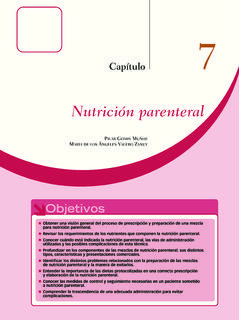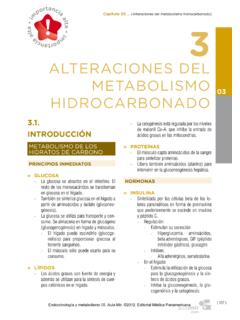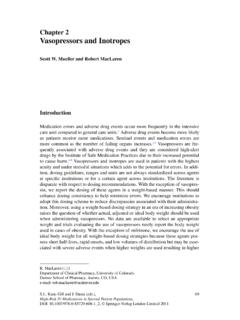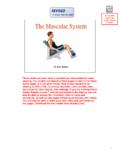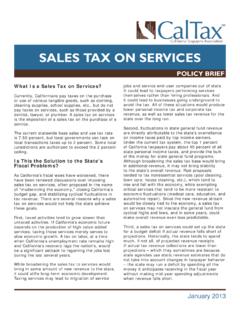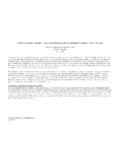Transcription of media.axon.es
1 85 Introduction Visibility: Good or Bad? Why Is It Important for Nurses to Be More Visible? Current Image of Nursing and How It Is Impacted by Past Images How Do Nurses View Themselves? Accessing Image and Increasing Visibility Advertising Nursing The Role of Media Media: Television, Radio, Film, Internet, Books, and Magazines Use of Media by Nurses Media Training Initiatives That Impact Image Nursing Initiatives to Address the Visibility of the Profession Nurses for a Healthier Tomorrow Raise the Voice Campaign Institute of Medicine Quality Series Reports The Future of Nursing: Leading Change, Advancing Health Strategies That Impact Image Generational Issues in Nursing: Impact on Image Power and Empowerment Assertiveness Advocacy The White Female Face of Nursing: It Needs to Change Men in Nursing Minorities in Nursing Professional Presentation: Increasing Visibility and Professional Growth What Do You Wear to Work as a Nurse?
2 Representing the Profession: Public Communication Skills Conclusion Chapter Highlights Linking to the Internet Discussion Questions Critical Thinking Activities Case Study Words of Wisdom ReferencesCHAPTER OUTLINE Examine critical issues related to visibility of nursing Describe the current and past image of nursing and critical related issues Explain how advertising and media impact the nursing image Discuss the advantages and disadvantages of the Johnson & Johnson campaign Explain the importance of the following nursing and healthcare initiatives and their relationship to image: Nurses for a Healthier Tomorrow, the Institute of Medicine s Quality Series reports, and the Future of Nursing report. Discuss strategies that impact image: generational issues, power and empowerment, and professional presentationCHAPTER OBJECTIVESAt the conclusion of this chapter, the learner will be able to:The Image of Nursing: What It Is and How It Needs to 8510/14/11 2:15 PM Jones & Bartlett Learning, LLC.
3 NOT FOR SALE OR DISTRIBUTION929886 SECTION I The Profession of NursingAdvertisingAdvocacyAssertivenessC olleagueshipEmpowermentImageInfluencePow erPowerlessnessKEY TERMSI ntroductionImage may appear to be an unusual topic for a nurs-ing textbook, but it is not. Image is part of a pro-fession. It is the way a person appears to others, or in the case of a profession, the way that profes-sion appears to other disciplines and to the general public consumers of health care. Image and the perception of the profession impact recruitment of students, the view of the public, funding for nurs-ing education and research, relationships with healthcare administrators and other healthcare professionals, government agencies and legisla-tors at all levels of government, and ultimately, the profession s self-identity.
4 Just like individuals may feel depressed or less effective if others view them negatively, professionals can experience similar reactions if their image is not positive. It impacts everything the profession does or wishes to content in this chapter focuses on the image of nursing from the perspectives of how the profession views its own image and how those outside the profession view nursing and nurses. Image is a part of any profession. How nurses view themselves their professional self-image has an impact on professional self-esteem. How one is viewed has an impact on whether others seek that person out and how they view the effectiveness of what that person might do. The content in this chapter includes discussion about the importance of visibility, the current image of nursing, various nursing initiatives that relate to image, and the importance of the media and of advertising nursing.
5 Examples of strategies that may impact image are described; particularly generational issues, power and empowerment, and examples are given regard-ing how nurses present themselves to communicate the value of the profession. Every time a nurse says to family, friends, or in public that he or she is a nurse, the nurse is representing the profession. This has an impact on the image of nursing. Buresh and Gordon stated, We cannot expect outsiders to be the guardians of our visibility and access to public media and health policy arenas. We must develop the skills of presenting ourselves in the media and to the media We have to take the responsibility for moving from silence to voice (Buresh & Gordon, 2000, as cited in Benner, 2005, p. 15). EXHIBIT 3 1 provides a snapshot of data that describe the nurs-ing : Good or Bad?
6 Although nurses comprise the majority of health-care professionals, they are largely invisible. Their competence, skill, knowledge, and judgment are as the word image suggests only a reflection, not reality (Sullivan, 2004, p. 45). The public views of nursing and nurses are typically based on personal experiences with nurses, which can lead to a narrow view of a nurse often based only on a brief personal experience. This experience may not provide an accurate picture of all that nurses can and do pro-vide in the healthcare delivery process. In addition, this view is influenced by the emotional response of a person to the situation and the encounter with a nurse. But the truth is that most often, the nurse is invisible. Consumers may not recognize that they are interacting with a nurse, or they may think someone is a nurse who is not.
7 When patients go 8610/14/11 2:15 PM Jones & Bartlett Learning, LLC. NOT FOR SALE OR DISTRIBUTION9298 ChapTEr 3 The Image of Nursing: What It Is and How It Needs to Change 87not mentioned is that knowledge and competency are required to do the year there is a National Nurses Week, and during this week there is a designated National Nurses Day, May 6, just as there is an annual rec-ognition week for many other workers and profes-sionals. This period was chosen because it coincides with Florence Nightingale s birthday, May 12, which is International Nurses Day. Nursing, pri-marily through the American Nurses Association (ANA), identifies an annual theme and issues that are emphasized during the week. An example of how the profession can use this week to highlight professional concerns in the policy arena occurred in 2007 when, as part of Nurses Week, the ANA and the Congressional Nursing Caucus (nurses who are in Congress) held a luncheon briefing for Congress that focused on an important nursing concern: safe patient handling.
8 Invited guests were congressional staff who dealt with health issues. Over the past decade, attention has been given to the health and safety concerns among healthcare workers. Despite the recognition that manual patient handling is a high-hazard task, the incidence of musculoskeletal to their doctor s office, they interact with staff, and often these patients think that they are interacting with a registered nurse (RN). Most likely, they are not, and the staff person is a medical assistant of some type or may be a licensed practical/vocational nurse. When in the hospital, patients interact with many staff members, and there is little to distinguish one from another, so patients may refer to most staff as does not mean that the public does not value nurses quite the contrary.
9 When a person tells another that he or she is a nurse, the typical response is positive. However, many people do not know about the education required to become a nurse and to maintain current knowledge, or about the great variety of educational entry points into nursing that all lead to the RN qualification. Con-sumers generally view nurses as good people who care for others. For the 11th consecutive year, the annual Gallup Poll listed nursing as number one in the annual list of occupations rated for honesty and ethical standards, with 81% of respondents agree-ing. This high vote of confidence has been a consis-tent annual result in the poll (Jones, 2010). What is EXHIBIT 3 1 Data on the Nursing Profession: 2008 Highlights Number of licensed registered nurses (RNs) in the United States grew by 5 percent between 2004 and 2008 to a new high of million.
10 Median age of RNs, 46 years old, remained the same between 2004 and 2008, but the number of RNs under age 30 increased for the first time in 3 decades. RNs salaries rose almost percent since 2004, which slightly outpaced inflation. Employment in nursing rose to almost 85 percent of RNs with active licenses, the highest since 1980. An estimated 444,668 RNs received their first license over the period from 2004 to 2008. Workforce diversity is up in 2008, percent of nurses were Asian, Black/African American, American Indian/Alaska Native, and/or Hispanic; an increase from percent in 2004. The United States has more licensed RNs than ever (an estimated 3,063,163 percent increase since the last survey in 2004).Source: Department of Health and Human Services (DHHS), Health Resources and Services Administration.



